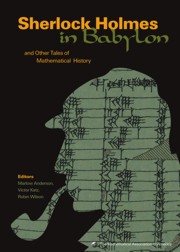Book contents
- Frontmatter
- Introduction
- Contents
- Ancient Mathematics
- Medieval and Renaissance Mathematics
- The Seventeenth Century
- Foreword
- An Application of Geography to Mathematics: History of the Integral of the Secant
- Some Historical Notes on the Cycloid
- Descartes and Problem-Solving
- René Descartes' Curve-Drawing Devices: Experiments in the Relations Between Mechanical Motion and Symbolic Language
- Certain Mathematical Achievements of James Gregory
- The Changing Concept of Change: The Derivative from Fermat to Weierstrass
- The Crooked Made Straight: Roberval and Newton on Tangents
- On the Discovery of the Logarithmic Series and Its Development in England up to Cotes
- Isaac Newton: Man, Myth, and Mathematics
- Reading the Master: Newton and the Birth of Celestial Mechanics
- Newton as an Originator of Polar Coordinates
- Newton's Method for Resolving Affected Equations
- A Contribution of Leibniz to the History of Complex Numbers
- Functions of a Curve: Leibniz's Original Notion of Functions and Its Meaning for the Parabola
- Afterword
- The Eighteenth Century
- Index
- About the Editors
Newton as an Originator of Polar Coordinates
from The Seventeenth Century
- Frontmatter
- Introduction
- Contents
- Ancient Mathematics
- Medieval and Renaissance Mathematics
- The Seventeenth Century
- Foreword
- An Application of Geography to Mathematics: History of the Integral of the Secant
- Some Historical Notes on the Cycloid
- Descartes and Problem-Solving
- René Descartes' Curve-Drawing Devices: Experiments in the Relations Between Mechanical Motion and Symbolic Language
- Certain Mathematical Achievements of James Gregory
- The Changing Concept of Change: The Derivative from Fermat to Weierstrass
- The Crooked Made Straight: Roberval and Newton on Tangents
- On the Discovery of the Logarithmic Series and Its Development in England up to Cotes
- Isaac Newton: Man, Myth, and Mathematics
- Reading the Master: Newton and the Birth of Celestial Mechanics
- Newton as an Originator of Polar Coordinates
- Newton's Method for Resolving Affected Equations
- A Contribution of Leibniz to the History of Complex Numbers
- Functions of a Curve: Leibniz's Original Notion of Functions and Its Meaning for the Parabola
- Afterword
- The Eighteenth Century
- Index
- About the Editors
Summary
The name of Newton, indissolubly linked with the calculus, seldom is associated with analytic geometry, a field to which he nevertheless made important contributions. Newton's use of polar coordinates, for example, seems to have been overlooked completely in the historiography of mathematics. The polar co-ordinate system is ascribed generally [1] to Jacques Bernoulli in 1691 and 1694, although it has been attributed [2] to others as late as Fontana in 1784. It is the purpose here to call attention to an application of polar coordinates made by Newton probably a score of years before the earliest publication of Bernoulli's work.
In the Horsley edition of the Opera of Newton there appears a treatise entitled Artis analyticae specimina vel Geometria analytica [3] which is essentially the same as the Newtonian Method of fluxions, published in 1736 by Colson. The discrepancy in titles—Geometria analytica or Method of fluxions — conveniently indicates that the work treats of coordinate geometry as well as the calculus. In fact, its analytic form stands in marked contrast to the synthetic style of the Principia, which also contained some elements of the calculus. The Method of fluxions makes systematic use of coordinates in problems on tangents, curvature, and rectification. Moreover, Newton did not limit himself, as had his predecessors, to a single type of coordinate system. Having shown how to use fluxions in finding tangents to curves given in terms of Cartesian coordinates, oblique as well as rectangular, Newton included some examples illustrating other types.
- Type
- Chapter
- Information
- Sherlock Holmes in BabylonAnd Other Tales of Mathematical History, pp. 274 - 278Publisher: Mathematical Association of AmericaPrint publication year: 2003



